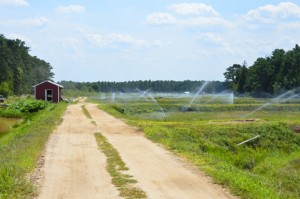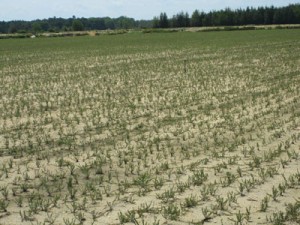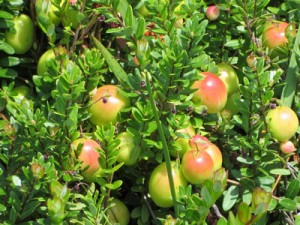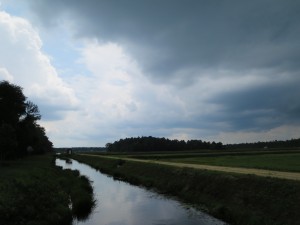We’ve had pretty standard New Jersey summer weather this year, but now that bloom is done and the vines are bearing fruit, our team is starting to focus on managing the heat. Once the fruit is formed, it’s important to keep them from what we term “scalding”. Scald occurs when the temperature is high but the dew point (humidity) is low; as Dr. Peter Oudemans likes to say, “When people are comfortable, the cranberries are in trouble.”
When humidity is low, applied water will readily evaporate and cool the fruit. During the day, if temperatures get up to around 95 degrees, we will turn on the irrigation in order to cool the bog down to the 80s. We’ll run the pumps for about an hour or two, depending on variables such as wind, temperature, and humidity. There is also a distinct difference between sending water through the root system and keeping the bog cool. The trick is avoiding complications from too much moisture, which can cause conditions that are welcoming to fungi such as phytophthora, which causes root rot. Vines shouldn’t be damp all the time; it’s a balancing act to keep the fruit at optimum growth conditions while avoiding oversaturation. The key to walking the tightrope is constant evaluation and always being aware of bog conditions.
“This year we’re waiting until we get a little more color on the fruit,” says Operations Manager Matt Giberson. “We ran irrigation a little bit in the early season just because the new vegetative growth was pretty tender, and the heat can cause that to wilt pretty quickly. We try to give them about 45 minutes at that stage. When the fruit starts to turn red is when we really start the heat run.” The weather has also been mostly cooperative: “Yesterday was hot but cloudy and humid; we felt like were dying out there but the plants were fine!” Communication is also key: “Mike [Haines] and I stay in contact all day long to make sure we’re on the same page.”
Once color is established, the team is looking into something new: kaolin clay treatment. “It’s applied via plane or buggy, and it’s supposed to help with sun scald,” Matt says. “Peter suggested it some time ago, but we needed to do some planning and think about possible side effects.” One concern with clay is that a heavy summer rain could wash it right off the plants, though we haven’t seen much rain, considering. “Rain-wise we could use a good inch! But at a slow rate, not an inch in ten minutes. That would be really nice!”
While the weather is unfortunately outside of our control, our team does its best every day to anticipate the possible effects!




